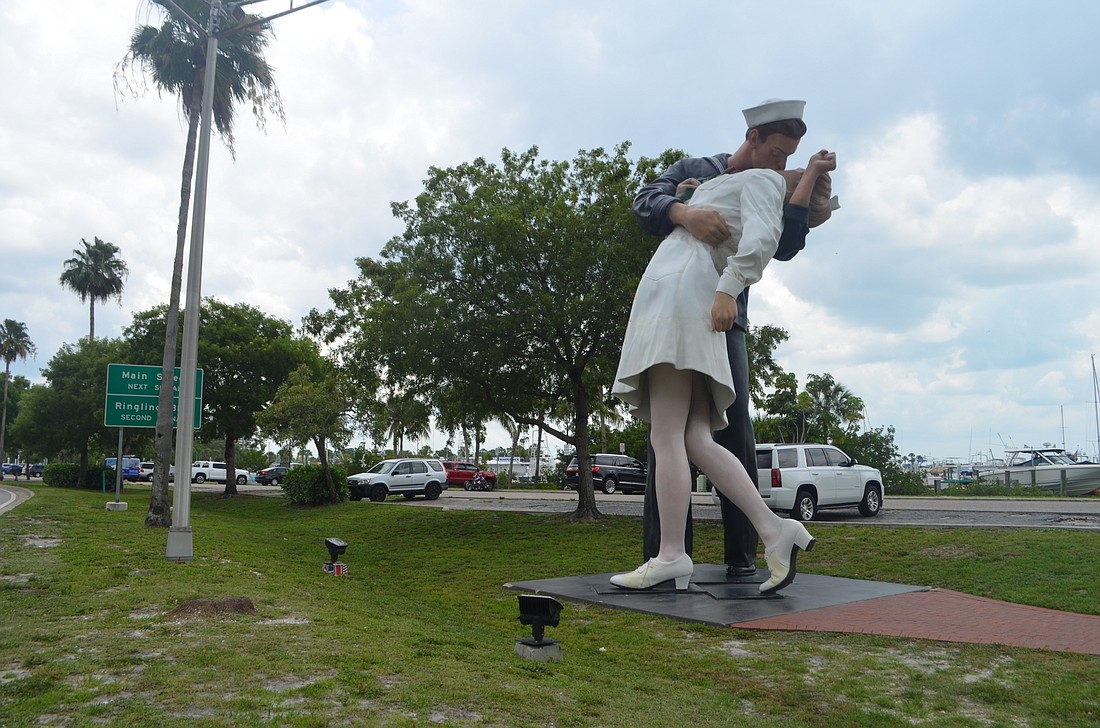- November 22, 2024
-
-
Loading

Loading

After more than a decade on the bayfront, could one of Sarasota’s most iconic pieces of public artwork find a new home on the east side of the city?
That was the recommendation of the city’s Public Art Committee last week, which voted unanimously to endorse relocating the “kissing sailor” sculpture Unconditional Surrender to the Sahib Shriners building at 600 N. Beneva Road. The proposal drew support from the Sahib Shriners organization and from veterans groups that called the artwork an important asset for Sarasota.
The conversation about a new home for Unconditional Surrender arose because the construction of a roundabout at U.S. 41 and Gulfstream Avenue in early 2021 will force the city to at least temporarily move the sculpture. Earlier this year, the City Commission agreed with staff’s recommendation to move the artwork into storage while the project is underway, but it also asked the Public Art Committee to discuss its long-term future.
That’s reopened a public debate over Unconditional Surrender, which has long been the subject of controversy. In 2009, when donor Jack Curan proposed lending the sculpture to the city with the condition it be placed on the bayfront for at least 10 years, the Public Art Committee unanimously voted against the idea. The City Commission approved the loan 3-2.
At a July 8 special meeting, the Public Art Committee was divided on whether the city should even keep the sculpture. A motion to return Unconditional Surrender to the Seward Johnson Atelier, the source of the artwork, failed in a 3-4 vote.
Some critics of Unconditional Surrender say the city should not display the sculpture, based on Alfred Eisenstaedt’s photograph V-J Day in Times Square in 1945, because it depicts a nonconsensual kiss. Greta Zimmer Friedman, the woman in the photo, said in a 2005 interview that it was not her choice to be kissed and that the sailor grabbed her.
In a video presented at the Aug. 7 Public Art Committee meeting, resident Kelly Franklin said the historically celebratory interpretations of the photograph and artwork do not erase the issues.
“For those who have never experienced the terror of having another person physically and literally bend them to their will, this sculpture might just be a fanciful bit of nostalgia,” Franklin said. “But for assault survivors, it’s an oversized PTSD trigger.”
As was the case in 2009, Unconditional Surrender has received support from veterans. Carlos Moreira, chairman of the Sarasota County Veterans Commission, submitted a letter to the city stating the veterans community had expressed a strong desire to keep the sculpture in Sarasota and near the bayfront. The group called the artwork a tribute to the joy felt at the end of World War II.
In response to those who criticized the sculpture as a depiction of a sexual assault, Moreira referenced Friedman’s New York Times obituary, which states her son “believed she understood the argument that it was an assault but did not necessarily view it that way.”
“If this was plain, black-and-white harassment, I would be in support of the city removing the statue,” Moreira said at the Public Art Committee meeting. “However, we don’t see it that way.”
Ahead of the Public Art Committee meeting, city staff produced a list of potential sites for relocating the artwork that ranged from Sarasota National Cemetery to Lido Beach.
The top contender that emerged from the meeting was not on staff’s list. Shriners President Gary Fields said the organization, a nonprofit with more than 60 years in the community, had a membership mostly made up of veterans. Fields said when he discussed moving Unconditional Surrender to the Sahib Shriners building, there was palpable excitement among the members. Fields said the Shriners were willing to raise funds to aid the move.
“We want it,” Fields said. “My members, their eyes lit up. You can see in their faces. They want to tell me stories of where they were at the end of World War II.”
For some members of the Public Art Committee, the Sahib Shriners site served as a sort of compromise, removed from its high-profile spot on the bayfront but preserved for those who enjoy it. At the meeting, Moreira said the veterans commission would support the Shriners building as the new home for the statue.
As part of its recommendation, the Public Art Committee also said it wanted the future display of Unconditional Surrender to include educational material — both about its significance to veterans of war and its issues for survivors of sexual assault.
“My personality is, I want to please many people,” Public Art Committee member Leslie Butterfield said. “I want art to bring a positive experience. This piece has many people who love it, many people who love it for the right reason. And also, people who hate it for their reason. I would really like to find some kind of a middle ground.”
During the meeting, city Planning Director Steve Cover cautioned against associating the appreciation of the artwork solely with the military.
“This isn’t a war memorial,” Cover said. “It’s a sculpture, a piece of art that’s really enjoyed by a lot of people, many of whom are not veterans.”
The City Commission is scheduled to discuss the Committee’s recommendations in September.